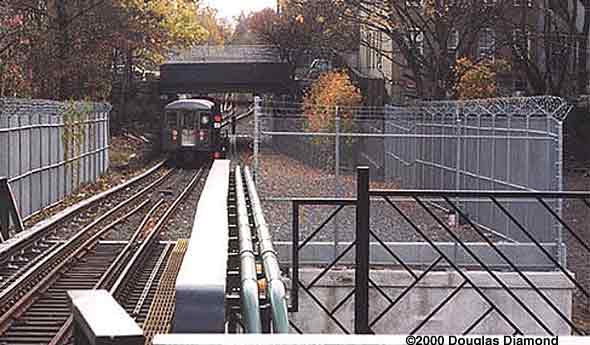The Third Century—
Brooklyn's Franklin
Shuttle Reopens

A
two-car set of modern R68 cars makes the transition to open cut
running south of Park Place station on the newly reopened Franklin
Shuttle, a movement made over a span of the 19th, 20th and 21st centuries
by subway, elevated and railroad passenger trains powered by third rail,
trolley wire and steam locomotives. The line returns to two tracks just
past the roadway bridge. Douglas Diamond
Foreword by Paul Matus
 first train ran on what is now the Franklin Avenue
Shuttle of the New York City Transit Authority, the line wasn't in
New York City. And only part of the line was even in the then-City of
Brooklyn. Most of what is now the Borough of Brooklyn consisted
of rural woods and farmland, more distant in time and place from
Brooklyn City than Long Island farmland is from New York City
today. first train ran on what is now the Franklin Avenue
Shuttle of the New York City Transit Authority, the line wasn't in
New York City. And only part of the line was even in the then-City of
Brooklyn. Most of what is now the Borough of Brooklyn consisted
of rural woods and farmland, more distant in time and place from
Brooklyn City than Long Island farmland is from New York City
today.
When the Brooklyn,
Flatbush & Coney Island Railway Co. opened its new steam excursion
railroad from the site of the current Prospect Park station to
Coney Island at Brighton Beach on July 2, 1878, the good burghers of the
Town of Flatbush knew they were seeing the handwriting on the
wall. Their rural community was still farmed by many of the same
old Dutch families who settled there when the area
was part of New Netherlands, but the 1870s were a time of enormous railroad
building in Kings County, what is now Brooklyn. It seemed only a matter
of time before great changes would be taking place in everyday life, and
the BF&CI was one of the instruments of that
change.
Almost seven weeks later, on
August 19, 1878, the BF&CI attained its goal of connecting with the
Long Island Rail Road at Bedford, the current junction of Franklin and
Atlantic Avenues, and what we now know as the Franklin Shuttle
saw its first passengers.
The new Brighton Line, as it was known virtually from day one, had an important advantage over other early steam roads to Coney Island—direct land access to the heart of Brooklyn City via its connection with the LIRR. But the route of its private right-of-way took it through developed areas of Brooklyn City and Flatbush Village where the residents were none to happy to have a steam railroad crossing their streets.
The Brighton responded
by building the line in an open cut through these areas, avoiding grade
crossings and a lot of local anger. The open cut ran from just south of
Park Place on what is now the Shuttle, to south of Church Avenue in
Flatbush on what is now the Brighton (D and Q train)
mainline.
Change came to the
Brighton right-of-way before the first passenger ever brushed coal soot
from his summer jacket—the open cut had to be dug deeper to accomodate the
larger LIRR locomotives for through service. From that point on, change
came frequently to the Brighton, but the biggest change, for the purposes
of our story, occurred on August 1, 1920. On that date, Brighton subway
trains began operating through a new tunnel from Prospect Park under
Flatbush Avenue, connecting it with the heart of Manhattan via the
Broadway Subway.
From that day the stations between
Prospect Park and Franklin Avenue became a distinct line as the new
Flatbush Avenue tunnel becme the main. Thus was born the Brighton-Franklin Line,
today's Franklin Shuttle. When the BMT assigned numbers to its routes,
the Franklin even received its own number 7, distinct from the
Brighton's 1.
As part of the building
of the new main line, the original cut from Prospect Park
to Church Avenue was rebuilt to four tracks, leaving only the Franklin's portion
in something like its 1878 appearance.
Through services were to continue in one form or another on the Brighton-Franklin
Line for another four decades, but the die had been cast—the Franklin Avenue
Line was now no longer the main line. Just as old highways retain
some of their original flavor when a new Interstate passes them by, so its
status as a branch line retained some of the flavor of the original
Brighton Line on today's Franklin Shuttle.
Other Readings:
The Malbone
Street Wreck by Brian Cudahy (Book Review)
Year 2000 Track Map of Franklin
Shuttleon 1942 street map. (~50K)
All material under copyright.
Text and illustrations may not be used without
explicit permission, except for quotations of reasonable length used in
critical reviews or scholarly commentary and attributed to "The Third Rail Online"
The Third Rail and The Third Rail logo are
trademarks of The Composing Stack Inc.
|
 March 2000
March 2000 